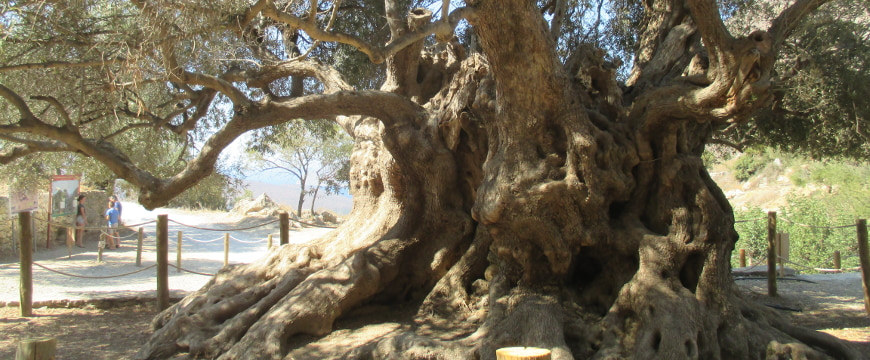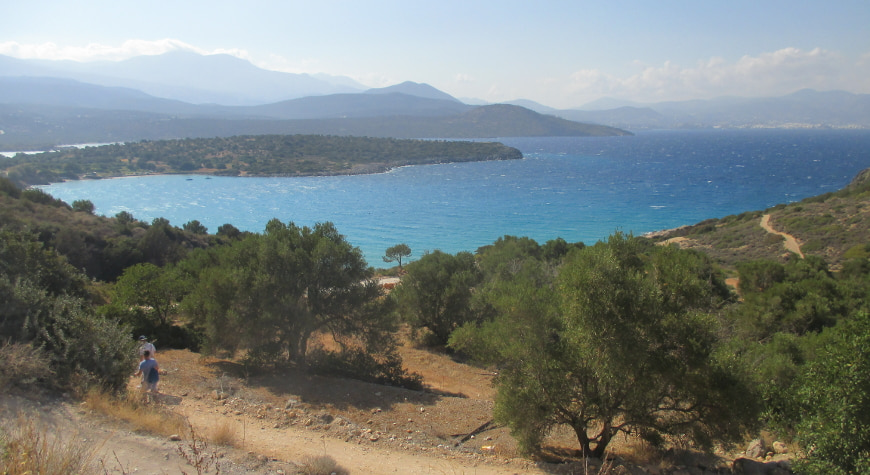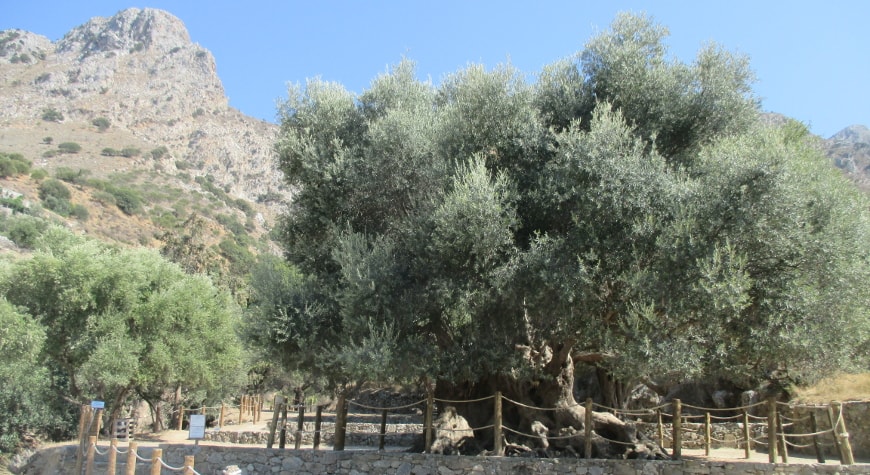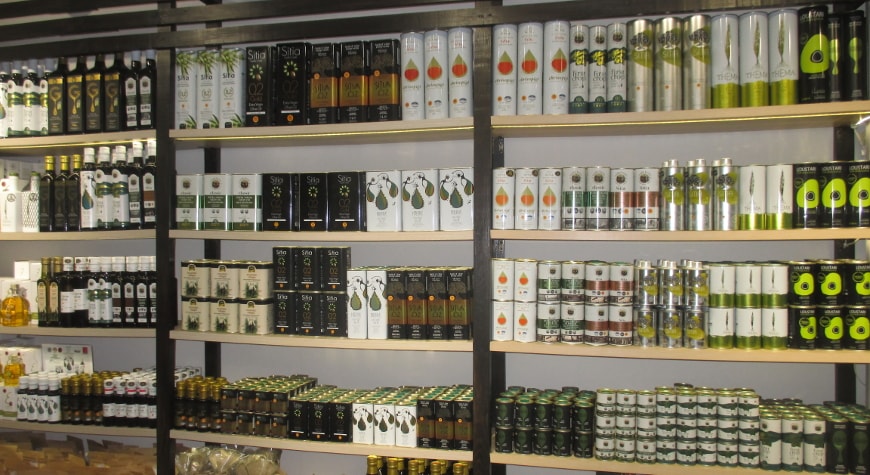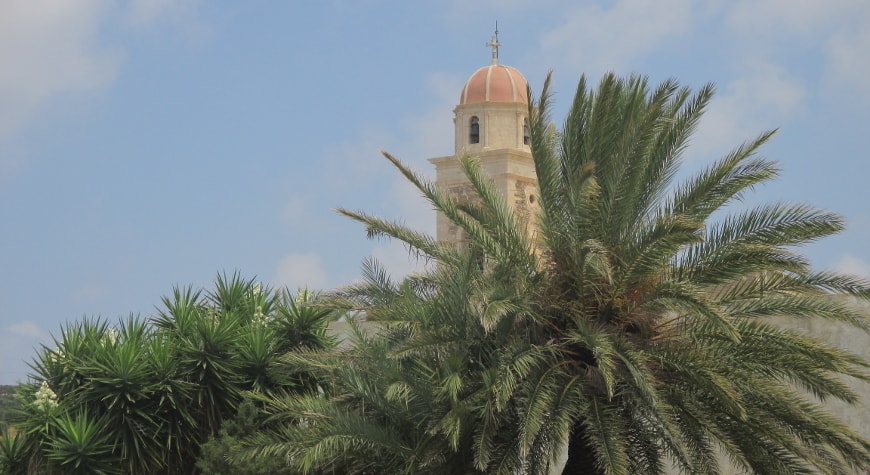If you visit northeast Crete, venture beyond the resorts of Agios Nikolaos and the unique palm forest next to Vai Beach. Discover an ancient monumental olive tree, a Greek café with a spectacular panoramic view and olive oil history lessons, a shop full of traditional local products, and a historic fortified monastery producing acclaimed wine and olive oil.
You can fly or sail to Sitia, a convenient base for travelers, or you can drive into the area from Agios Nikolaos or farther west on the generally good, scenic, meandering highway. Between Agios Nikolaos and Sitia, you’ll weave around forested hills, passing oleander, pine, eucalyptus, and cypress trees and olive groves with silvery green leaves undulating in the island’s winds. You’ll catch glimpses of blue sea between the hills, with the most stunning olive grove and sea views around Pachia Ammos.
Coming from Agios Nikolaos on the main road, you’ll pass through the village of Kavousi. Shortly before leaving the village, turn right by the sign for the Monumental Olive Tree of Kavousi (or Azoria), and follow a roughly paved road for two kilometers, up to what locals call the oldest olive tree on earth. (There are one or two sections of gravel and dirt road, and some narrow parts with deep potholes, but our car made it; other visitors hiked part or all of the way up the hill.) You can continue farther, if you wish, to the Kastro and Azoria archaeological sites, after admiring this impressive tree.
It is impossible to determine the precise age of this monumental olive tree without cutting it down, but its diameter (4.9 meters at the widest) and its perimeter (14.2 meters) suggest that it is approximately 3,250 years old, according to a sign erected by the Association of Cretan Olive Municipalities. It is an olive tree (Olea Europa) of the Mastoidis (Muratolia) variety grafted onto a wild olive tree (Oleaster). Although I have lived on this island where olive groves cover one quarter of the land for almost 16 years, I have not seen a larger olive tree.
With hills and cliffs rising above us and olive groves all around us, we can examine this enormous tree. The sculpturesque trunk spreads wide, with manifold bulges forming its own landscape of hills and valleys, caves and craters, even some glacial root segments. The waving canopy of branches and leaves rises up high and extends far out above us.
When you are ready to descend to Kavousi, enjoy the especially impressive view of the valley and sea. Back on the main road to Sitia, we can also stop at the Panorama Café / Restaurant in Platanos to fully appreciate the scenery. The café is right next to the road, across from a stone water fountain and an informative sign, below a tiny church with a bell tower. Panorama is well named for its unobstructed view of the sea and the little island of Pseira, with hills rising beyond the sunstruck ripples of the bay on our left.
In addition to very good coffee, waffles, snacks, and traditional Greek food made with their own olive oil, Panorama adds an unusual element for a Greek restaurant: two large, illustrated informative signs from the Association of Cretan Olive Municipalities that discuss the olive tree civilization in this part of Crete, plus a portrait of the ancient tree we saw at Kavousi (which locals call Azoria). The café also sells some bottled, branded Cretan olive oil, herbs, and other local products.
If you are looking for a wider range of local products, continue to the town of Sitia, where we can visit the Kipseli Cretan Traditional Products shop on K. Karamanli Street, across from the small boat pier at the port. The shop features an extensive selection of Cretan extra virgin olive oils (EVOOs), including 14 conventional EVOOs, 10 organic EVOOs, and a number of flavored olive oils, plus olives, olive spreads, olive wood kitchen implements, local herbs, sweets, pasteli, a wide variety of honey, tsikoudia, ouzo, Toplou and Economou wine, natural cosmetics (some made with olive oil from Heraklion), pottery, and textiles.
Sofia and Manos Savidakis, the sister and brother who opened the shop this May, are also beekeepers who produce honey in Sitia for the Toplou monastery brand, as well as being olive farmers and tsikoudia makers. (An unusually detailed website focused on their honey explains the production process, from the bees in the thyme flowers to the jar.) Sofia and Manos welcome customers to their Kipseli store with a traditional drink and the opportunity to taste various types of olive oil and eight types of honey in order to select their favorites.
Their brochure emphasizes that “Crete, the birthplace of the ‘Mediterranean Diet,’ offers local products of excellent quality,” all part of “the nutrionally rich Cretan diet, which is a way of life and an important factor in health and longevity.” To arrange a “fully guided tasting experience” in the store that includes explanations of the products and their uses and pairings (for 5 euros per person), tourists can call +30 28430 25833 or email This email address is being protected from spambots. You need JavaScript enabled to view it..
Sofia told Greek Liquid Gold that their tasting experience includes a presentation of four local olive oils, a discussion of “the history of olive oil in Sitia and how we produce it,” and a similar discussion and tasting of three varieties of local wine and rakomelo (tsikoudia with honey). They also present the family’s honey and offer participants samples of a number of other local products, including olive spread, rusks, cheeses, olives, and apaki (a Cretan cured meat).
For another wine and olive oil tasting and a different experience of Cretan culture and history, visit the 14th century fortified Toplou Monastery, its church, its museum, and its tasting room. To learn more about that, see Greek Liquid Gold’s article The Art of the Church and the Winery: Toplou Monastery.
All businesses, organizations, and competitions involved with Greek olive oil, the Mediterranean diet, and/or agrotourism or food tourism in Greece, as well as others interested in supporting Greeks working in these sectors, are invited to consider the advertising and sponsorship opportunities on the Greek Liquid Gold: Authentic Extra Virgin Olive Oil website. The only wide-ranging English-language site focused on news and information from the Greek olive oil world, it has helped companies reach consumers in more than 220 countries around the globe.


